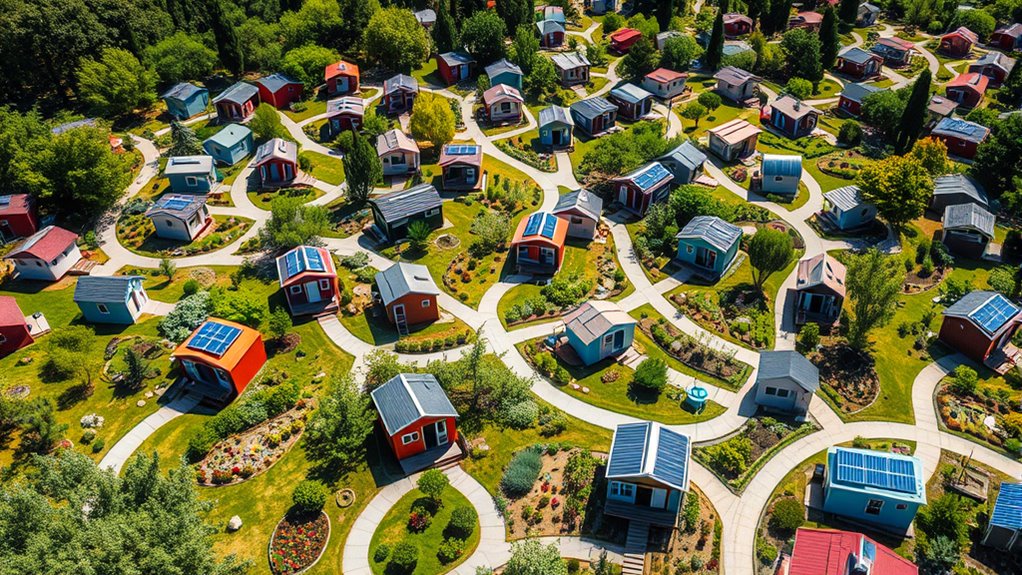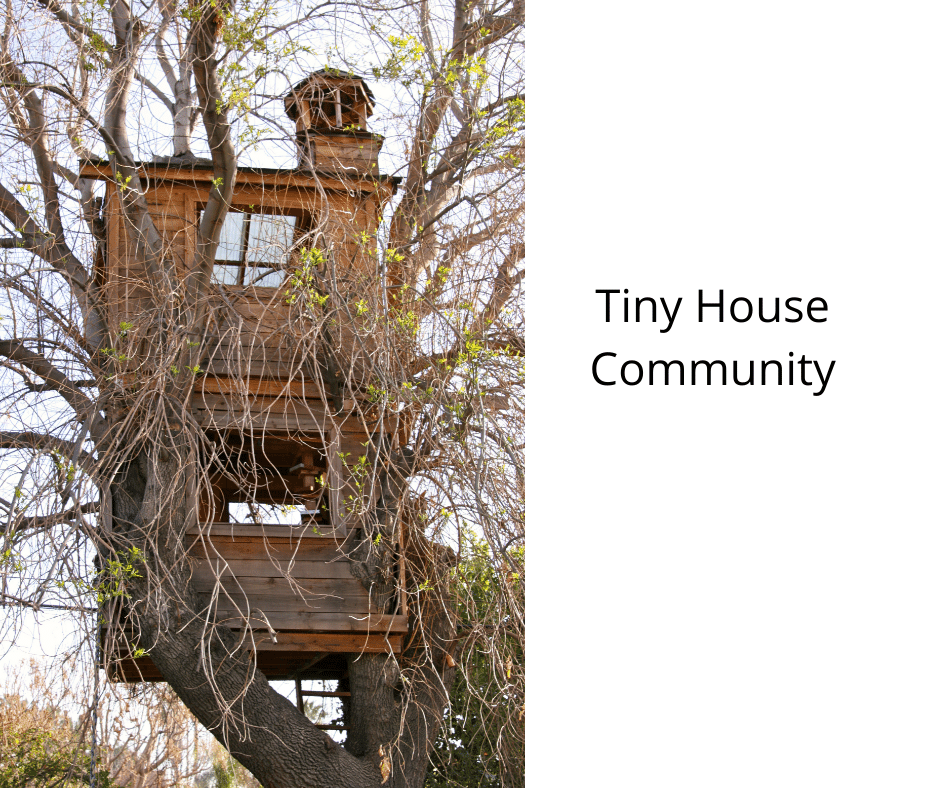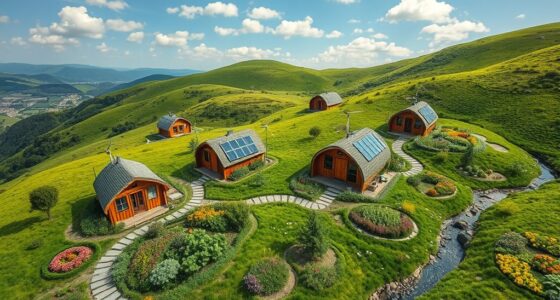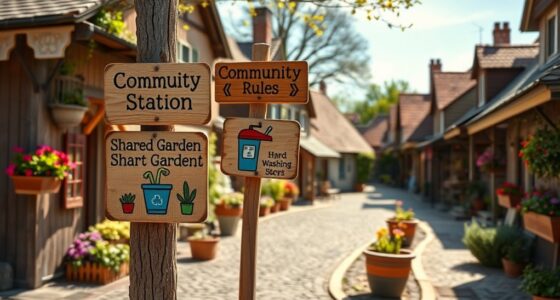Exploring America’s best tiny house communities reveals vibrant, eco-friendly neighborhoods that emphasize sustainability, social connection, and affordability. These communities feature energy-efficient homes, shared amenities, and green infrastructure like solar panels and rainwater harvesting. You’ll enjoy reduced living costs while living closer to nature and neighbors. If you’re curious about how these communities foster greener lifestyles and strong social bonds, there’s a lot more to discover about their innovative designs and shared values.
Key Takeaways
- Top tiny house communities prioritize sustainable living with solar energy, rainwater harvesting, and eco-friendly infrastructure.
- They offer shared amenities like community kitchens, recreational areas, and organized social events to foster connection.
- These communities promote eco-conscious transportation options, reducing environmental impact and supporting a greener lifestyle.
- Cost-effective living is achieved through resource sharing, energy efficiency, and lower utility bills.
- They create supportive environments that emphasize community, affordability, and environmental preservation for a simplified lifestyle.

Have you ever wondered if there’s a better way to live more sustainably and affordably? Tiny house communities offer a compelling answer. These neighborhoods focus on sustainable living, allowing residents to reduce their ecological footprint while enjoying a close-knit environment. By choosing a tiny house, you’re not just downsizing your living space—you’re embracing a lifestyle that prioritizes efficiency, community, and environmental consciousness. Many of these communities are designed with shared amenities that promote social interaction, reduce costs, and cultivate a sense of belonging. From communal gardens to shared workspaces, community amenities are central to the tiny house experience, making it easier to live sustainably without sacrificing comfort or convenience.
Living in a tiny house community means you’re part of a collective effort to minimize waste and energy consumption. These communities often feature solar panels, rainwater harvesting systems, and composting facilities, all aimed at reducing environmental impact. The smaller footprint of each tiny home naturally requires less energy for heating, cooling, and maintenance, which translates into lower utility bills and less strain on natural resources. Plus, because many communities emphasize sustainability, you often find programs encouraging recycling, composting, and eco-friendly transportation options like bike-sharing or electric vehicle charging stations. This focus on sustainable living isn’t just good for the planet—it also helps you save money and lead a healthier lifestyle.
Community amenities in tiny house neighborhoods extend beyond just eco-friendly features. Shared spaces like community kitchens, laundry facilities, and recreational areas foster a sense of camaraderie and reduce household costs. Instead of maintaining multiple appliances or outdoor equipment, you share resources, which cuts expenses and promotes eco-conscious habits. Many communities also organize events, workshops, and social gatherings, making it easy to connect with neighbors and build lasting relationships. This sense of community is one of the biggest benefits, especially if you’re seeking a supportive environment that encourages collaboration and mutual aid. Additionally, the emphasis on sustainable living practices ensures that residents are actively contributing to environmental preservation while enjoying a simplified lifestyle.
Choosing to live in a tiny house community means embracing a lifestyle that’s more affordable, more sustainable, and more connected. The integration of community amenities simplifies daily life while fostering a shared commitment to eco-friendly living. It’s about creating a space where you can thrive without excess, surrounded by neighbors who share your values. In these communities, sustainable living isn’t just a trend—it’s a way of life that offers freedom from the high costs and environmental toll of conventional housing. By making this choice, you’re stepping into a future that’s greener, more affordable, and more community-oriented.
Frequently Asked Questions
What Are the Average Costs of Tiny House Communities?
The average costs for tiny house communities range from $300 to $700 monthly, covering community living expenses like shared amenities and maintenance. If you’re considering tiny house financing, keep in mind that upfront costs for the tiny home itself can vary widely based on size and features. Budget for both your tiny house purchase and ongoing community living expenses to guarantee a smooth shift into this minimalist lifestyle.
How Do Zoning Laws Affect Tiny House Communities?
Zoning laws considerably impact tiny house communities by imposing zoning restrictions that determine where you can place tiny homes. These restrictions often create legal challenges because many areas weren’t designed with tiny houses in mind. You might face obstacles like minimum lot sizes or restrictions on mobile dwellings, making it harder to establish or expand tiny house communities. Understanding local zoning regulations helps you navigate these legal challenges and find suitable locations for your tiny home lifestyle.
Are Tiny House Communities Environmentally Sustainable?
Like Gaia nurturing Earth, tiny house communities often embrace sustainability. You’ll find eco-friendly materials and sustainable building practices at their core, reducing environmental impact. These communities usually prioritize renewable energy, water conservation, and waste reduction, making them a greener choice. By minimizing resource use and opting for eco-conscious designs, you actively participate in protecting the planet while enjoying a simpler, more intentional lifestyle.
What Amenities Are Typically Available in These Communities?
In these tiny house communities, you’ll usually find amenities like shared gardens, communal gathering spaces, and sometimes fitness areas. The tiny house design often maximizes space efficiency, making your home cozy yet functional. Community events are common, fostering connections among residents. You might also enjoy amenities like laundry facilities, Wi-Fi, and outdoor areas for socializing or relaxing, all designed to enhance your living experience and promote a strong sense of community.
How Do Residents Handle Waste Management and Utilities?
Back in the day, you’d think living tiny meant sacrificing comforts, but not here. You’ll handle waste with composting systems and use solar power for electricity, making your home eco-friendly. Residents typically have designated areas or hookups for utilities, reducing environmental impact. You’ll find that with smart planning, waste management and utilities become seamless, giving you the freedom to focus on enjoying your minimalist lifestyle without worrying about the basics.
Conclusion
As you explore America’s best tiny house communities, you’ll see how they’re transforming living spaces and fostering tight-knit connections. Did you know that the tiny house movement has grown by over 63% in the past five years? This statistic highlights how more people are embracing minimalist, sustainable lifestyles. Whether you’re seeking a simpler life or community-focused living, these neighborhoods prove that big dreams come in small packages. It’s an exciting trend worth experiencing firsthand.








